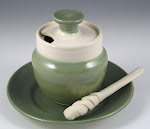Tulips came to Holland from Asia. A tulip bulb cost at least
as much as your ox, when this beautiful flower was new and novel. And if you
were Someone, you needed to upstage your peers by exhibiting your incredibly unusual and extremely expensive prize in an appropriately over-the-top container.
You put it with its fellow tulips (because you were wealthy enough to have enough for a bouquet) in a
fancy-shmancy vase made just for them.
Your vase would probably have had several levels, like a
layer cake, each layer with holes, tubes or spouts in which to insert the tulip
stems. Since your tulips were still alive and still bending towards the light
source even after being cut, they might keep on bending till they keeled right
over. So you constrained the stem to the holes or narrow tubes in your special vase,
so that they would stay upright.
My take on tulipieres began with vases,
thrown on the wheel (2600 grams of clay each), altered by being squashed inward a bit, with the rims crimped into two, then three, then four
openings. I have a feeling they may get more openings as I make more tulipieres…
Phase one. Just thrown. Waiting to firm up a bit before I
start adding appendages to them.
 |
| first tulipiere, thrown round then pushed inward, with 2 rim openings |
 |
| 2nd tulipiere, flared, flattened a bit, with 3 openings |
 |
| 3rd tulipiere, flared shape, flattened form, with 4 rim openings |
Remember, this is just the interesting first part of the process.
Tomorrow: the tulipiere shapes get evened out, and begin to sport spouts.

They look sort of like the menorah formed out of tubes of clay that you made years ago.
ReplyDeleteCorrect you are, GilaB. They do look a bit similar. One difference is that I made the menorah tubes as separate units, and these tulipieres were made by pinching together the walls of the thrown vase, which gives them a more organic vibe. By comparison, the menorah was industrial looking.
ReplyDeleteTubes are a natural form, and cylinders are a basic building block in pottery, the first thing you must learn to master on the wheel. They are bound to recur in my work. There is nothing new under the sun, right?
You will find these pieces much altered by the time I'm done, by the way.